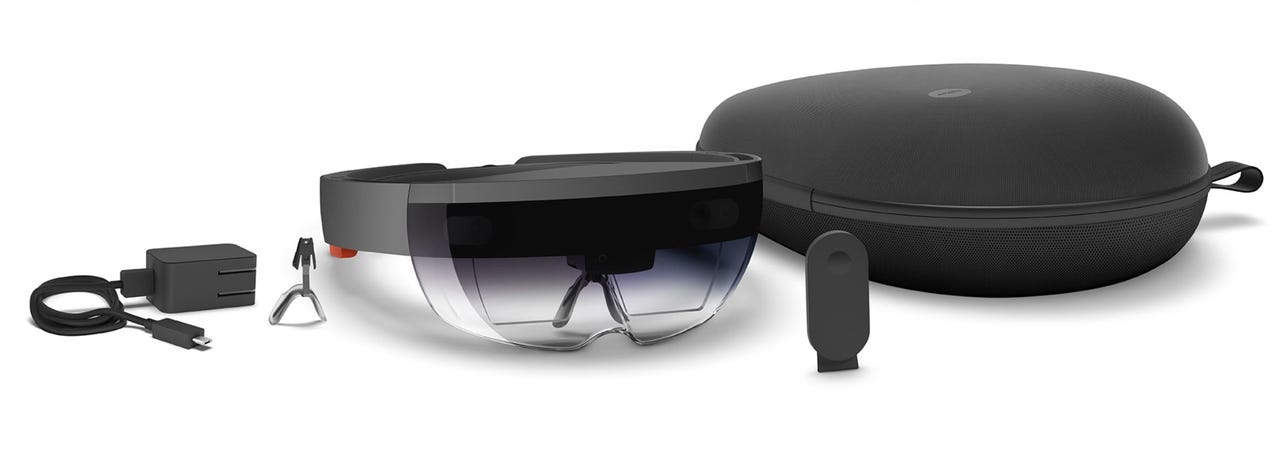Microsoft to start shipping $3,000 HoloLens developer kits on March 30

Starting today, February 29, Microsoft will begin allowing invited developers to buy the Development Edition of Microsoft's HoloLens mixed-reality goggles, which will start shipping March 30.

In addition to including the HoloLens goggles and developer environment, the Developer Edition will come with a Bluetooth clicker; carrying case; charger and cable; microfiber cloth; nose pads; and overhead strap, Microsoft officials said today.
The HoloLens developer environment includes the HoloStudio, a program for creating 3D in 3D; a version of Skype that will allow people to communicate using holograms; the Microsoft HoloTour holographic travel app; and three examples of mixed-reality games.
HoloLens runs a variant of Windows 10, and the programming interfaces for holographic computing are available as part of the OS. Developers, starting today, get access to the HoloLens documentation and tutorials. Additional development tools that include Visual Studio projects and a HoloLens emulator will be available to devs once the devices start shipping on March 30, Microsoft officials said.
In order to develop for HoloLens, developers need Windows 10 PCs running Visual Studio 2015 and Unity 5.4.
Officials also said today that starting this summer, developers will be able to "experience a completely new holographic storytelling medium for the Development Edition that we call Actiongram."
Information about Actiongrams, which are a mashup of holograms and videos, leaked last week. There are already a group of HoloLens developers who are privately testing the device and building Actiongrams. The built-in cameras in HoloLens allow users to record mixed-reality captures, which are HD pictures and videos of the holograms that users can share with others who don't have HoloLens devices.
Microsoft officials also publicly acknowledged today that the first-generation HoloLens devices will have two to three hours of active use. A Microsoft employee told some developers about the battery life of the HoloLens during a private event earlier this year. Microsoft execs said the developer version of the HoloLens will offer up to two weeks of standby time; will be fully functional when charging and will be passively cooled, meaning no fans.
There's still no word when Microsoft will begin selling HoloLens devices to business or consumer customers. The creator of the HoloLens, Alex Kipman, recently said that Microsoft would take its time to roll out the device so as not to repeat the mistakes it made with the Kinect sensor, which fizzled due to a lack of supporting apps and content, among other reasons.
Update: Here is Microsoft's spec list for the Developer version of the HoloLens:
Optics
• See-through holographic lenses (waveguides)
• 2 HD 16:9 light engines
• Automatic pupillary distance calibration
• Holographic Resolution: 2.3M total light points
• Holographic Density: >2.5k radiants (light points per radian)
Sensors
• 1 IMU
• 4 environment understanding cameras
• 1 depth camera
• 1 2MP photo / HD video camera
• Mixed reality capture
• 4 microphones
• 1 ambient light sensor
Human Understanding
• Spatial sound
• Gaze tracking
• Gesture input
• Voice support
Input / Output / Connectivity
• Built-in speakers
• Audio 3.5mm jack
• Volume up/down
• Brightness up/down
• Power button
• Battery status LEDs
• Wi-Fi 802.11ac
• Micro USB 2.0
• Bluetooth 4.1 LE
Battery Life
o 2-3 hours of active use
o Up to 2 weeks of standby time
o Fully functional when charging
• Passively cooled (no fans)
Processors
• Intel 32 bit architecture
• Custom-built Microsoft Holographic Processing Unit (HPU 1.0)
Weight
• 579g
Memory
• 64GB Flash
• 2GB RAM